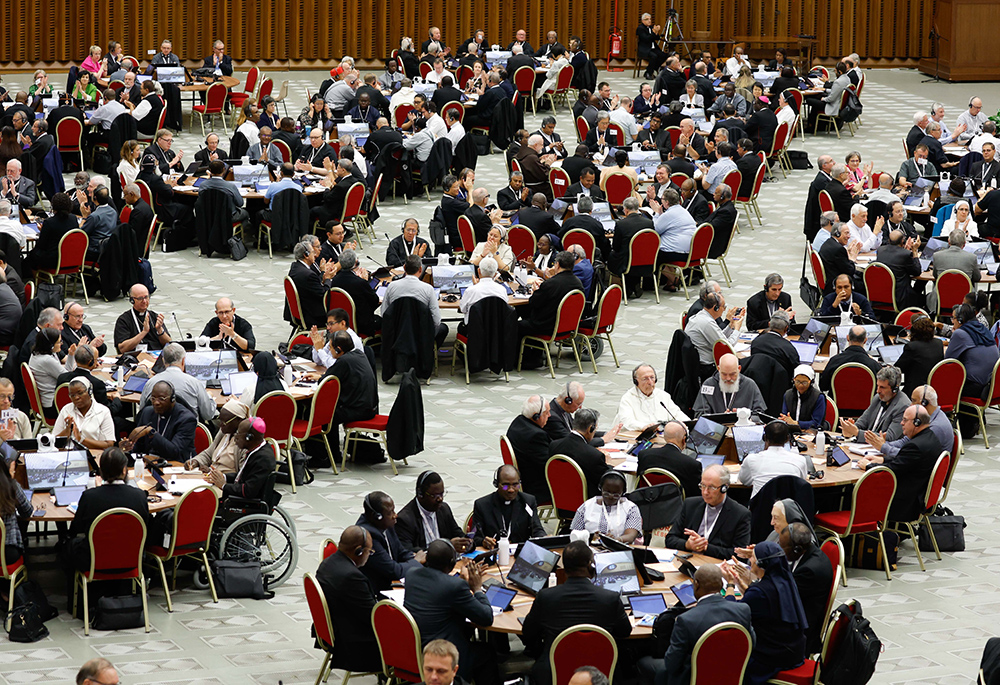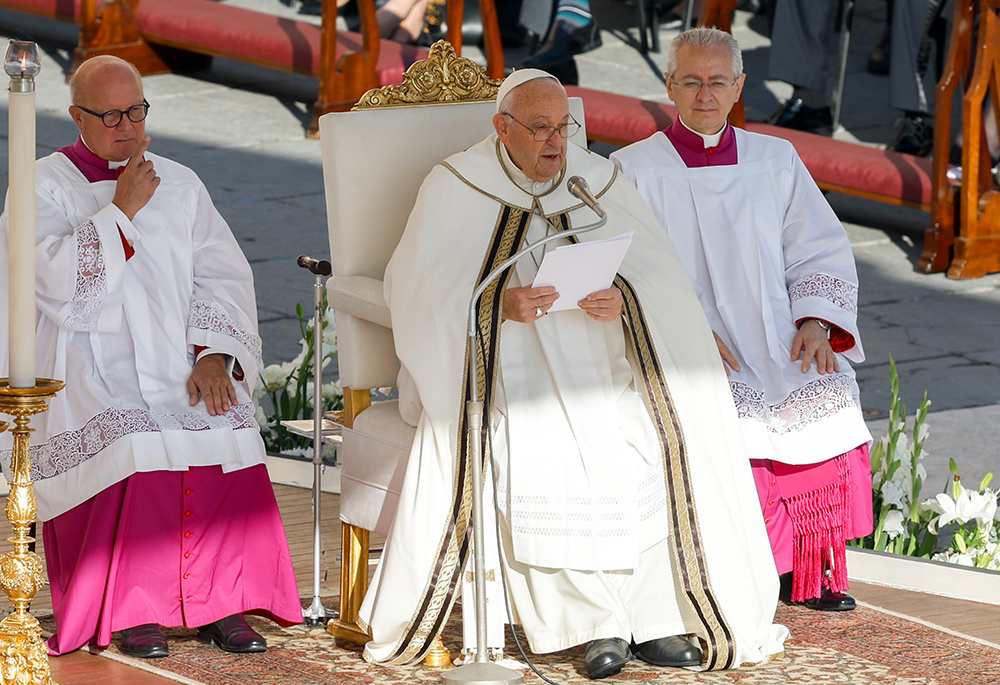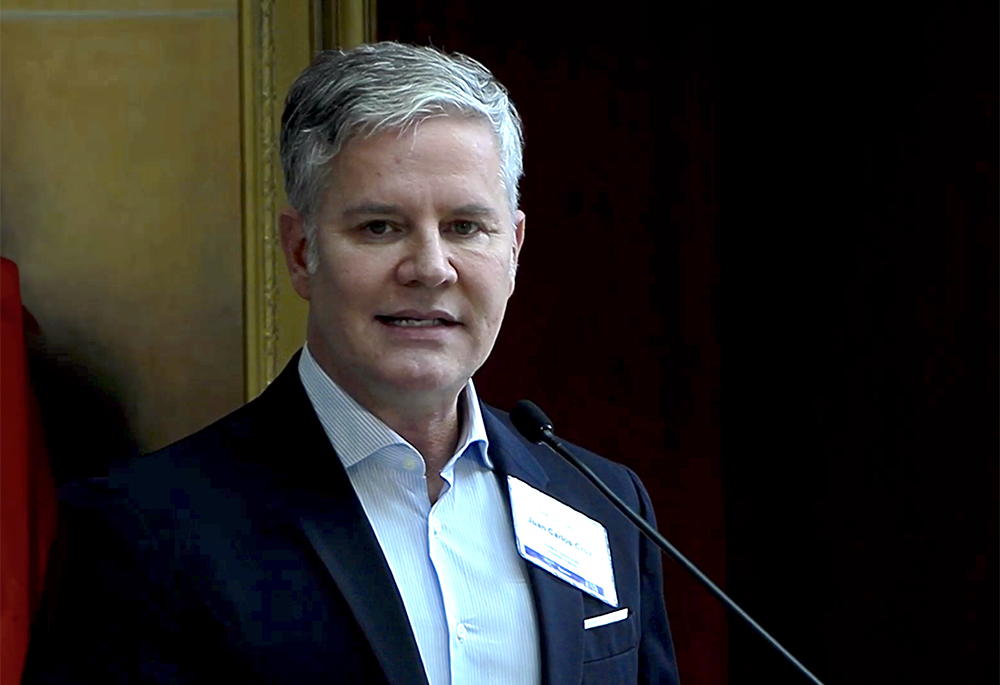
Members of the assembly of the Synod of Bishops start a working session in the Vatican's Paul VI Audience Hall Oct. 18, 2023. (CNS/Lola Gomez)
At the beginning of October, a landmark gathering of church leaders sat down at roundtables in a brightly lit hall. The event was diverse as far as ecclesial gatherings have historically gone; the participants spanned generations, genders, ideologies and cultural backgrounds. Many were vowed religious, but some were laypeople.
Everyone in attendance knew their purpose. They came to listen, dialogue and discern together how the church might address some of the most pressing issues of our day in more inclusive and healing ways.
The gathering wasn't the one you might be thinking of, the groundbreaking synod on synodality in Rome. It was the National Catholic Conference on Restorative Justice, a biennial convening that took place in October at the University of St. Thomas School of Law in Minneapolis.
As one of the conference organizers, I can say truthfully that the event wasn't designed to be a "synod in miniature." And yet, it was also unsurprising that the conference mirrored the synod in so many ways, from invoking the Holy Spirit, to the hallmark roundtables, to the overarching vision of "inspir[ing] people to dream about the church we are called to be … to stimulate trust, to bind up wounds, to weave new and deeper relationships."
Put simply, these two gatherings bore such striking resemblances because their subject matter does also. Both synodality and restorative justice encompass a vision and a process for journeying together amid woundedness and division. Both aim to leverage the power of deep listening, authentic dialogue, and radical truth-telling to illuminate a path toward communion and, ultimately, healing.
Now is the time for the church to recognize and embrace the synergistic relationship between synodality and restorative justice, because though the 2023 Rome-based assembly has ended, the work of the synod is far from over. Engaging restorative justice now — putting to use its time-tested principles and practices in our parishes and ministries — can help us become the listening, reconciling church we are called to be.
Though not regularly expressed in these terms, the synod on synodality is fundamentally a response to harm in the church. Injustices like clergy sexual abuse, clericalism, polarization and marginalization loomed large on the docket in Rome. Similarly, the restorative justice conference in Minneapolis looked at four specific areas of harm: injustice in the criminal legal system, clergy sexual abuse, racial injustice, and harms against Native peoples. In all these spheres, the church has been responsible for varying degrees of inflicting harm, perpetuating it, concealing it, or looking the other way.

Pope Francis gives his homily at the Mass opening the assembly of the Synod of Bishops in St. Peter’s Square Oct. 4, 2023, at the Vatican. (CNS/Lola Gomez)
In the synod's opening Mass, Pope Francis emphasized that wounds like these need to be addressed head-on: "The synod serves to remind us of this: our mother the church is always in need of purification, of being 'repaired.' "
Restorative justice is an approach rooted in exactly the kind of repair Pope Francis speaks about. Where more "traditional" notions of justice might focus on a specific law or rule that was broken and how to punish the responsible party, restorative justice seeks to identify the harm, to understand its impact, and to discern what can be done to put things more right.
Restorative justice processes come in various forms, but they all share a common aspect: elevating the voices of those who've been most directly affected. During the restorative justice conference, every plenary session included people who were impacted by the harm in question.
Monique Maddox was one of these courageous witnesses. A lifelong Catholic and a descendant of enslaved individuals who were once owned and sold by the Jesuit order, she now leads a nonprofit representing thousands of these descendents of Jesuit enslavement. "As descendants, we went to the Jesuits," Monique recalled during a plenary session on racial injustice. "We went to those who harmed our families and we said, 'You taught us this faith, you taught us this religion. … We're not going away. We're here to stay. We're here to speak, and we want to be the people who are naming how we're going to be satisfied.' "

Juan Carlos Cruz, a member of the Pontifical Commission for the Protection of Minors and a survivor of sexual abuse by a priest in his native Chile, speaks Oct. 6 at the National Catholic Conference on Restorative Justice in Minneapolis. (NCR screenshot)
The conference also underscored the grave repercussions of failing to listen to survivors or silencing them entirely. During one conference panel, Juan Carlos Cruz, a survivor of clergy sexual abuse in the Chilean church and a member of the Pontifical Commission for the Protection of Minors, shared, "People have died waiting for justice. Friends of mine have committed suicide waiting for justice." Notably, the commission issued an unusually strong statement the week before, demanding greater attention from the synod to the issue of clergy sexual abuse: "No one should have to beg for justice in the Church," it implored.
The courageous truth-telling at the conference not only embodied the principles of restorative justice, it also served as a tangible expression of synodality in action. Indeed, listening to those on the margins, bearing witness to their pain, their needs, and their God-given dignity, is where the process of becoming a synodal church takes root.
But it doesn't end there. The synthesis report published at the close of the synod captured the necessity of translating listening into meaningful action: "Openness to listening and accompanying all … has made visible many who have long felt invisible. [But] The long journey toward reconciliation and justice, including addressing the structural conditions that enabled such abuse, remains before us and requires concrete gestures of penitence."
Certainly, there is more work to be done here. The October assembly has already been criticized for offering little in the way of concrete reform. But notably, the synod was never intended to "resolve" a litany of problems; it was always about finding new ways to engage with these issues as a church.
Here again, we should look to restorative practices, which seamlessly lend themselves to fostering the very "conversations in the Spirit" that the synod has called for. One of these restorative practices is known as "circle process." Rooted in Indigenous peacemaking traditions, the practice involves participants coming together in a circle and, with the support of a facilitator, engaging in meaningful dialogue on a range of prompts and questions. Often I have found that circle process allows us to slow down enough, to listen closely enough, that room is created for the Holy Spirit to enter in and illuminate a new way forward.
"If we desire for our parishes and communities to embrace synodality more fully, we should look to restorative practices, which seamlessly lend themselves to fostering the very 'conversations in the Spirit' that the synod has called for."
The synod structure in Rome effectively mirrored a circle process (remember the roundtables?). Facilitators guided small groups of delegates through multiple rounds of sharing, ensuring that everyone's voice was heard in equal measure. It was in this circle structure that cardinals, teenagers, women religious, and patriarchs — even the Holy Father himself — engaged in the dialogue.
Restorative practices are already gaining traction in Catholic communities. Some have started using circle process as a means to foster community and address polarization, like in the Archdiocese of Chicago, where parishes have organized talking circles to engage in conversations about racial justice. Similarly, parishes like Our Lady of the Holy Cross in Baden, Missouri, have employed a circle process structure to hold discussions about the weekly Sunday Gospel.
The Diocese of San Diego even used circles during its listening phase of the synod last year. "Throughout our diocese's two month process of meeting in this restorative way," remarked Bobby Ehnow, who directs the diocesan Office of Life, Peace and Justice, "I was reminded time and again that circles … can be a powerful method for communicating as a faith community."
Advertisement
Throughout the centuries, the church has demonstrated that it is capable of inflicting immense harm, but we must remember that we, the body of Christ, also have incredible potential for atonement and repair. To engage in synodality and restorative justice is to take responsibility of what is ours to do in the work of transforming the church from "wounder" to "healer," just as it was commissioned by Christ to be.
Over the next 10 months until the assembly convenes again in Rome, I pray we see restorative justice become an integral part of our synodal journey. We've already witnessed how restorative practices can help us tackle harm and injustice in a manner that resembles Jesus' reconciling way.
Restorative justice teaches us to embrace unfinished endings, recognizing that healing is an ongoing journey. In the words of Pope Francis, "Today we do not see the full fruit of this process, but with farsightedness we look to the horizon opening up before us."








